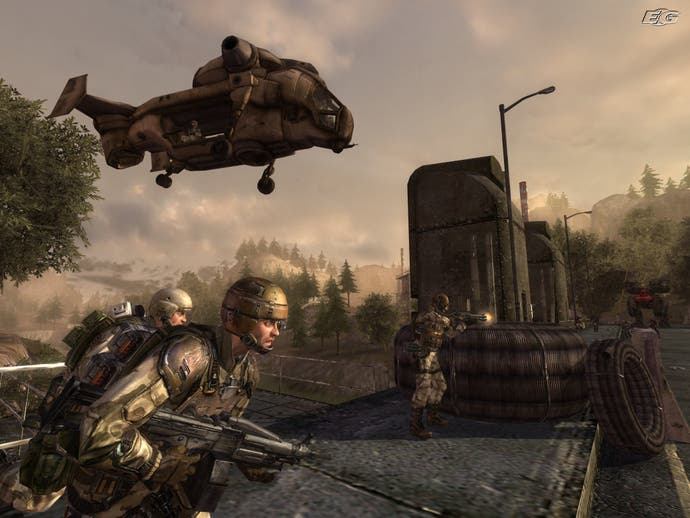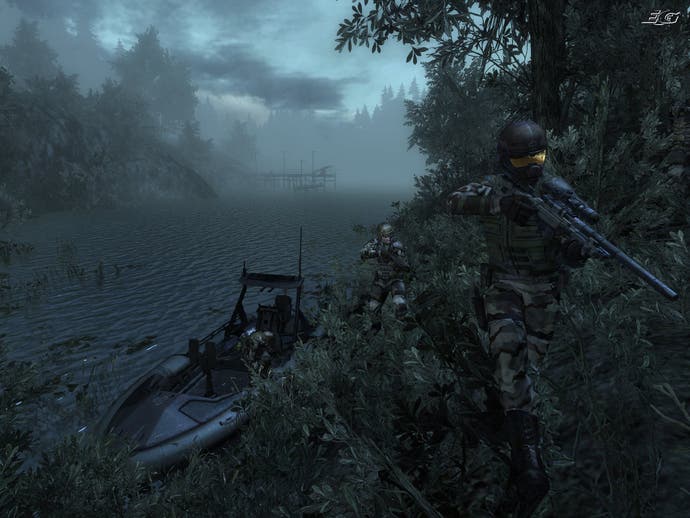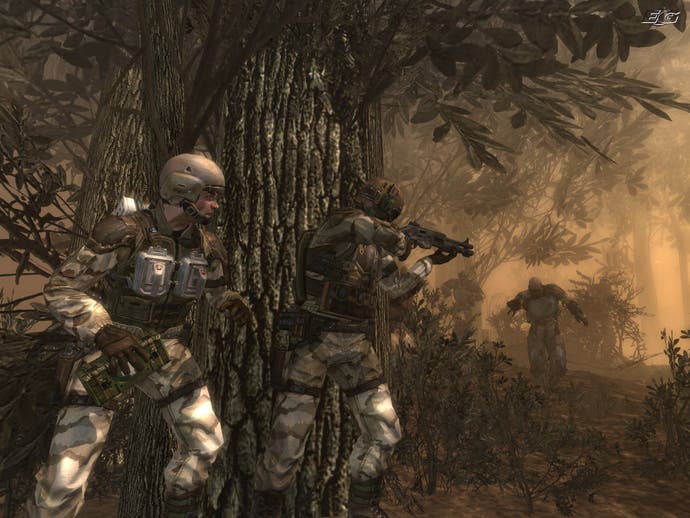Enemy Territory: Quake Wars
The Battlefield of the future?
When you watch the Enemy Territory: Quake Wars trailer, it's easy to leap to conclusions about what the game's going to be. It's Battlefield in the Quake universe! It's getting railgunned in the face by twitch-killers as you stand next to a spawnpoint for a vehicle. It's people rocket-jumping into choppers and weirdo aliens going "hoooo-maaan!" as they pilot Chinooks into your base and capture a flag and then bunny-hop off into the sunset, unmolested by players who've driven their buggies into a ditch in the middle of nowhere and can't find their way back to where the action is.
This is certainly a developer thrilled to be working with id Software. Sitting in Splash Damage's boardroom in Bromley, our eyes are drawn to three clocks on the wall, one showing local time, another "Activision" and another "id Software". Before our presentation begins, game designer and managing director Paul Wedgwood points at his company's logo on the trailer's final screen. "That's us!" he gestures, animatedly. And they really are working with id Software. There's this perception that id just farms out its games these days, but the relationship is close. Co-owner Kevin Cloud is creative director on the project, while Robert Duffy is technical director. Indeed, while we're chatting, Duffy's apparently on the other side of the office doing Wedgwood's job, although he's being kept away from us. "Kevin and I also work together for about three of four hours a day on the telephone or via ICQ," says Wedgwood with enthusiasm.
And yet, rather like the preconception about id's working habits (not entirely helped by John Carmack's current predilections for mobile games and building rockets), the suggestion that Enemy Territory: Quake Wars is some sort of Stroggification of Battlefield is equally quick to run aground. It's not. It's not like that at all. In fact, it has more in common with the developer's Return to Castle Wolfenstein multiplayer game, also called Enemy Territory.

While it's set in the Quake universe, on Earth during the Strogg invasion prior to the events of Quake 2 or Quake 4, Enemy Territory: Quake Wars it doesn't borrow any technology or art from either game. It's not like Battlefield with Quake movement code; it's relatively "realistic", with players in first- and third-person view squaring off as teams of distinctive classes and vehicles. And while it's set on huge maps - a mile square is the default - full of vehicles, it adopts an asymmetrical approach more like the Wolfenstein ET, with players representing the Earth's Global Defence Force striving to liberate areas split into distinct territories, starting in one area and trying to push the frontline past a sequence of objectives, using a range of weapons and vehicles that are utterly divorced from those of the alien would-be-conquistadors.
"This allows for a really varied range of tactics that encourage teamplay," says Wedgwood. Indeed, individual units don't just struggle against one another; some are hideously mismatched. The Titan tank is a powerful GDF unit, but the Strogg's Goliath walker, a giant mech with a gun turret on top, can stomp over pretty much everything in the game. And although some reports have talked about a potential commander class akin to Battlefield 2's, Wedgwood says they gave up on that idea more than two years ago. "Where it comes to things like deployables, we place the responsibility for a deployable that a character class is going to use with that character class," he says, "so if you're a field-ops guy and you want an artillery gun, you're the guy who deploys the artillery gun, you're the guy who gets told what its status is, and you're the guy who uses it." This sharing of responsibilities is a key to effective, cohesive teamplay, he says. We're shown examples of this - when a Strogg gun appears on a bridge, an engineer sets up radar that detects it, but it's the assault classes who can accept the task of destroying it and earn points. "We try to spread the deployables across the character classes, and then that way no one ever feels like they have an absolute dependence on an individual. The flip side is that there is always a dependency on the whole team."

Without a central commander, and with the frontlines moving to specific positions with each fallen Strogg territory, it's always going to be obvious where the action is. Vehicles will help people to reach it, and it'll be possible to have them dropped in to order by giant supply planes when stranded, although this will be balanced to avoid abuse. And in spite of this compartmentalisation, which favours specific combat lines to all out conflict, SD wants to avoid people piling into melees respawn after respawn. Given the way that players co-operate, contributing to a collective goal in specific ways, it's easy to imagine how this will be achieved, and while there won't be a player cap as such, the ideal player number is going to be between 24 and 32, and each map is designed to reflect this.
To further simplify how gameplay unfolds, we're shown a topographical map of one of the levels in the game - each of which is said to be close in size to a whole Wolfenstein ET campaign. The map's clearly split into zones, mostly Strogg-controlled but for one GDF area. As the GDF advances, so will the action and their spawn points. Each map also serves the storyline of the Quake series - in this case, the Strogg are trying to contaminate a water supply and it's up to the GDF to work their way to the contamination plant and cripple it. In others, we'll get a glimpse of how Earth discovered slipgates, came to have the hyper-blaster and the railgun, and so on.

As to how the GDF advances, we're given a pretty good runthrough of what's available. Players earn the right to bring deployables to an area by moving their command vehicle there, and then field-ops can deploy artillery, airstrike capability and powerful missiles (SSMs) in different ways. For example, SSMs need someone to lace the target with a highly visible laser for several seconds first. Some vehicles can have their wheels blown off, so engineers need to conjure up replacements. Medics resuscitate fallen comrades and heal wounded soldiers. Rangers lead the way into battle, and others cover field-ops busy with laser-designation, engineers busy with wrenches and medics busy with stitches.
Vehicles obviously play a big role and the maps are designed to allow certain applications and not others. A quad bike can race through trenches and jump off ramps to cross rivers; Titan tanks can rumble over debris that other vehicles can't traverse; amphibious APCs can take a dip and mount beach landings.

We didn't see as much of the Strogg as we did the GDF, but their vehicles were distinct and gave us an idea of the balancing measures SD has taken. The Strogg have a jet-pack device called Icarus, which allows players to hover for a limited time and bears most comparison to the quad bike in terms of manoeuvrability. But, er, it can fly - to make up for this, they're lit up like Christmas trees with two enormous orange boosters either side of the player's head, and we're told it's easy for GDF forces to get a lock onto them. The hornet flyer, meanwhile, is bound by other constraints - on a basic level, it's a chopper equivalent, but its movement style, based on four multidirectional boosters, allows it to shoot up and backwards in ways a chopper can't match, leading to some interesting dogfight prospects. Then of course there's the Goliath, where one player can pilot it and another man the 360-degree gun turret on top; if someone wants to do both jobs, he'll have to sacrifice manoeuvring to get that 360-degree turret capability, and sacrifice those 360 degrees for the narrow firing arc of the pilot's seat.
SD wants to avoid the kind of embarrassing problems people had with choppers in BF2 by setting the learning curve up a bit differently. "The goal behind this vehicle was to create something that newbies could fly very easily," Wedgwood says of the GDF chopper, "but that you could then pull of lots of advanced moves in. So when you first take off you can't mess up by moving your mouse around; it's only when you get clear of the terrain that you start to get proper control. When you get better, you can shoot out of windows, you can use thrusters to fly it a bit more like a jet, and we can leave advanced moves up to what the player's comfortable with."


.png?width=291&height=164&fit=crop&quality=80&format=jpg&auto=webp)




.jpg?width=291&height=164&fit=crop&quality=80&format=jpg&auto=webp)
